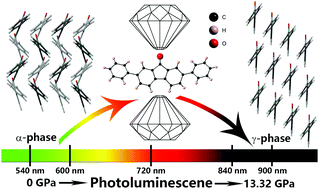Drastic photoluminescence modulation of an organic molecular crystal with high pressure†
Abstract
Pressure is an effective method to modulate the optical properties of organic solid-state light-emitting materials through enhancing intermolecular interactions and/or generating new polymorphs. Herein, we find that the organic molecular crystal of diphenylfluorenone (DPFO) undergoes a large-scale and continuous redshift of the UV-vis absorption and photoluminescence (PL) spectra under high pressure, across the entire visible light region. Remarkably, a redshift of about 300 nm was observed for its PL peak at 13.32 GPa, from greenish-yellow to the near-infrared (NIR) region. The in situ high-pressure IR spectra and synchrotron X-ray diffraction (XRD) analyses suggest a phase transition from the α- to the γ-phase (newly identified) at around 3 GPa, accompanied by the phenyl unit in DPFO converting from perpendicular to parallel packing. Theoretical calculations show that the enhanced π⋯π interactions and the overlap of the molecular orbitals in the γ-phase are responsible for such a tremendous redshift in the PL spectra. Our work highlights the large redshift phenomenon in the DPFO system under high pressure, which may have potential photonic device applications. Furthermore, this work reveals the clear structure-property relation, providing deep insight into the tailoring of the optical characteristics of molecular materials.

- This article is part of the themed collections: 2019 Materials Chemistry Frontiers HOT articles and Celebrating the 100th anniversary of Nankai University


 Please wait while we load your content...
Please wait while we load your content...